Blog & Latest Updates
Fly Fishing Articles
Insects by Common Name


> > The West Branch of the Delaware River
Landscape & scenery photos from the West Branch of the Delaware River
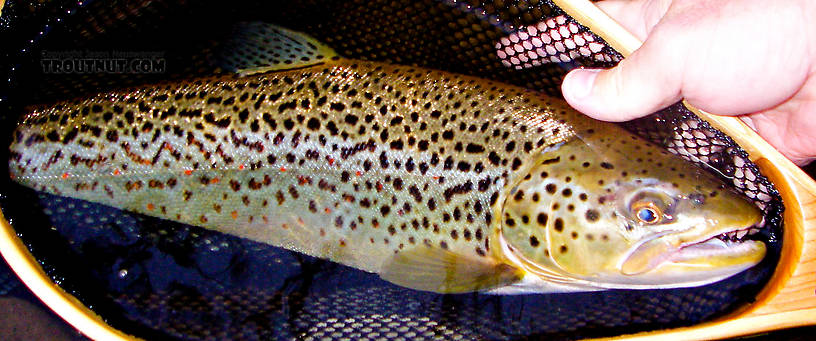
This fish almost got me into the coveted "20/20 club." It's a 20 inch brown caught on sulphur-flavored Galloup's Cripple tied on a size 18 3X-fine dry fly hook. It's also my biggest fish to date from the Catskills.
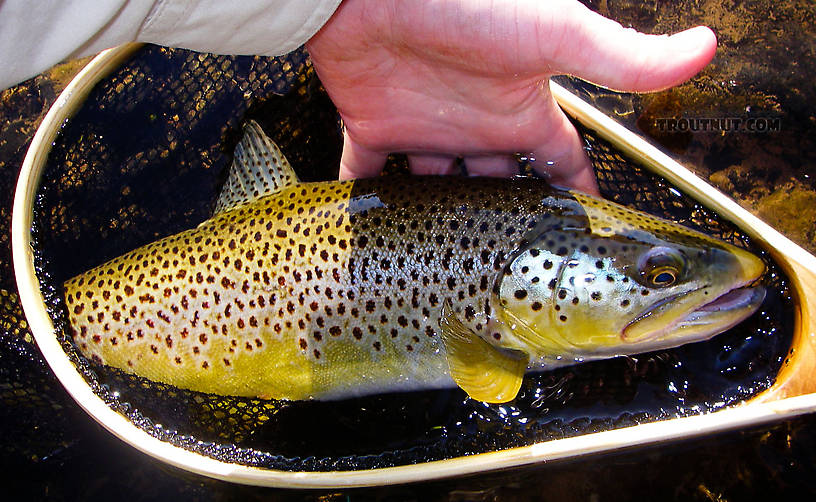
An 18-inch Catskill brown trout.

A late winter sunset radiates over a Catskill ridge. This picture is taken near a popular landing on one of the main tailwaters.
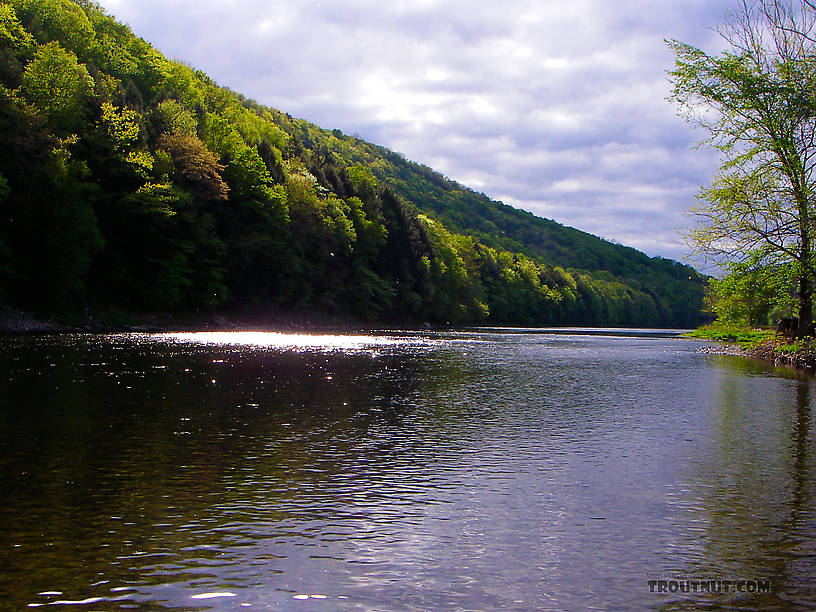
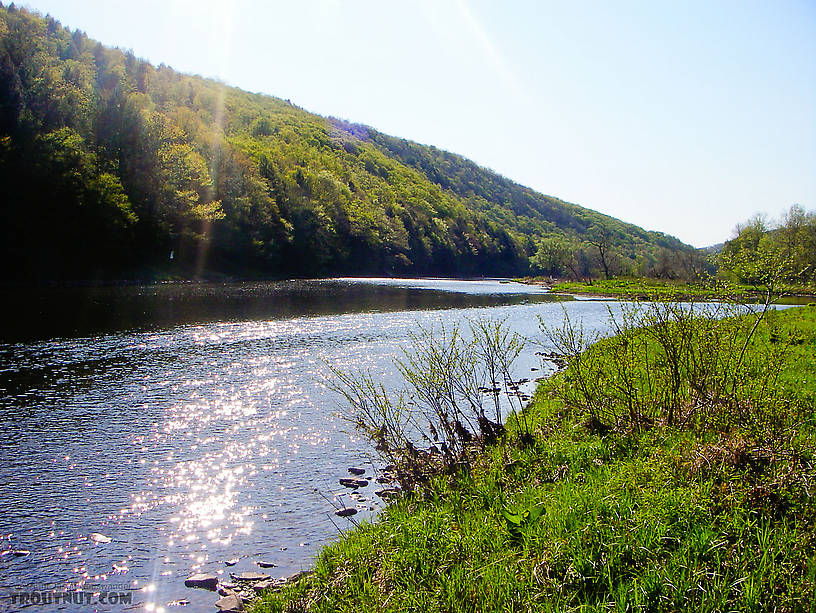
Underwater photos from the West Branch of the Delaware River
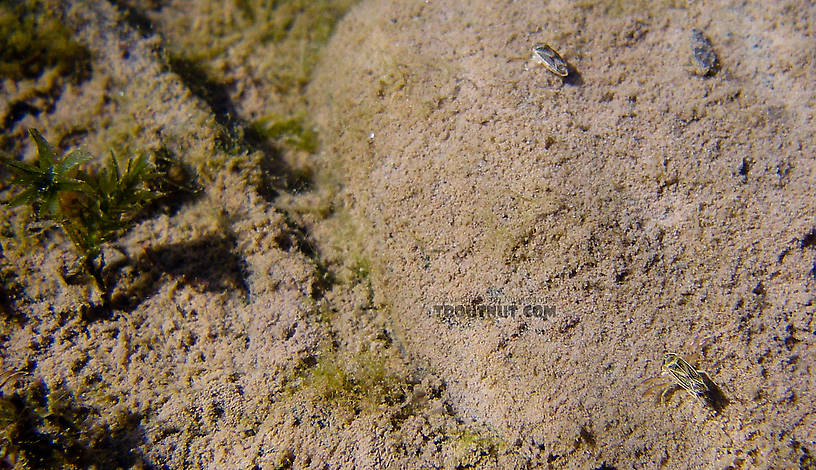
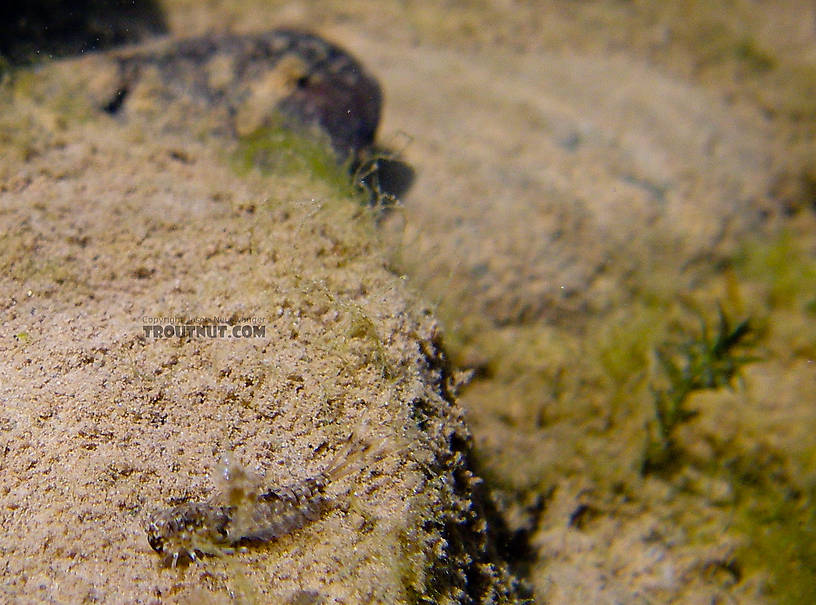
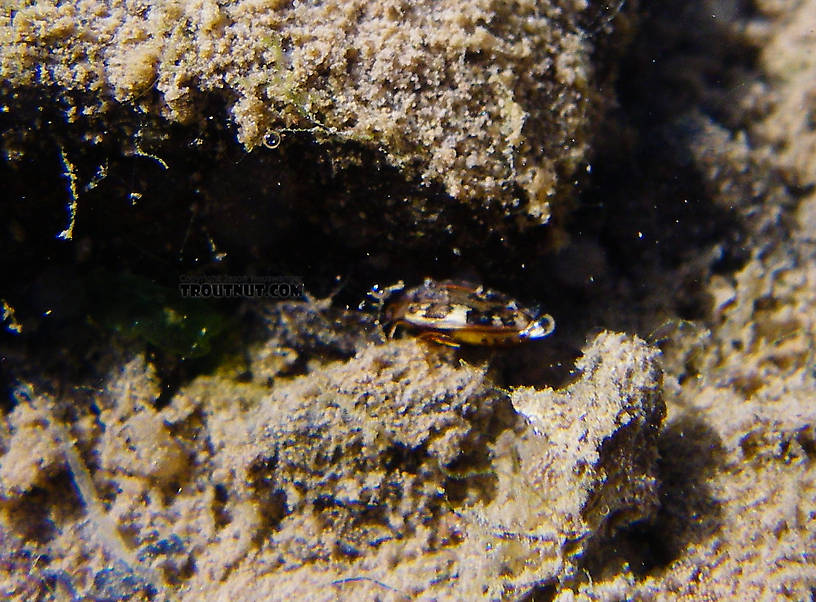
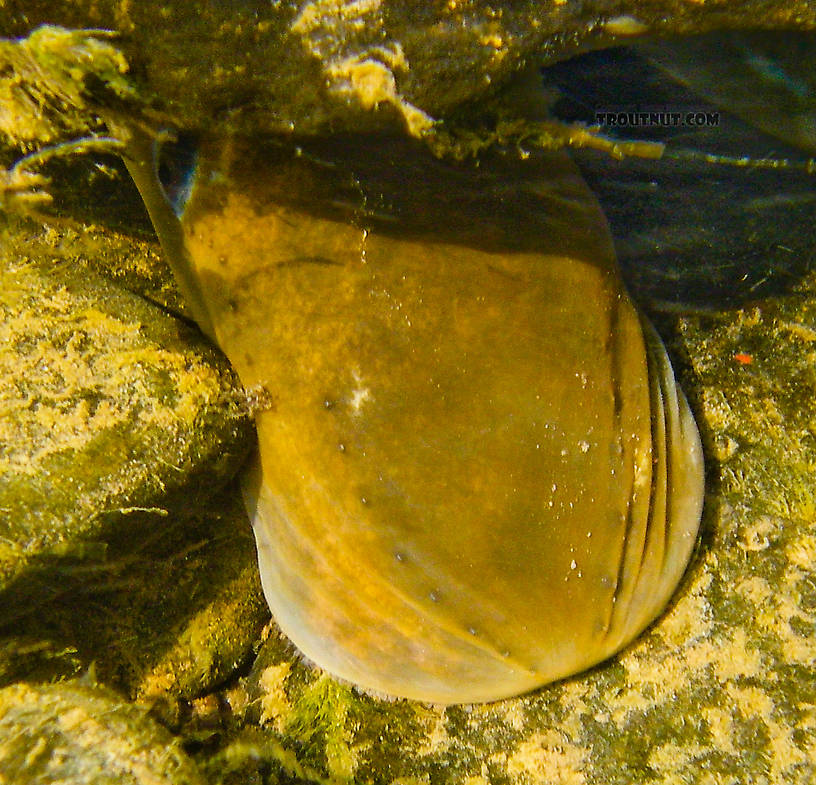
Here's the head of a sea lamprey which migrated up the Delaware River to spawn.
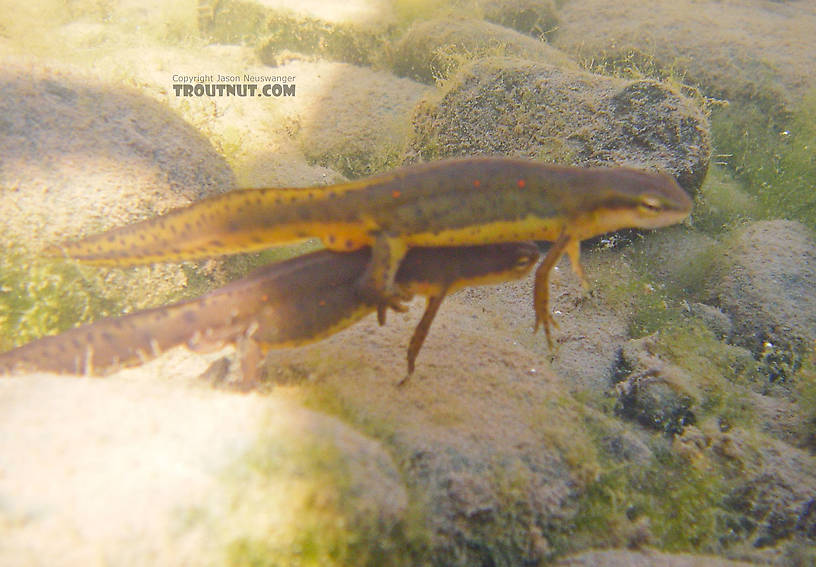
These are red-spotted newts, Notophthalmus viridescens viridescens. Thanks Gonzo for the ID.
On-stream insect photos from the West Branch of the Delaware River
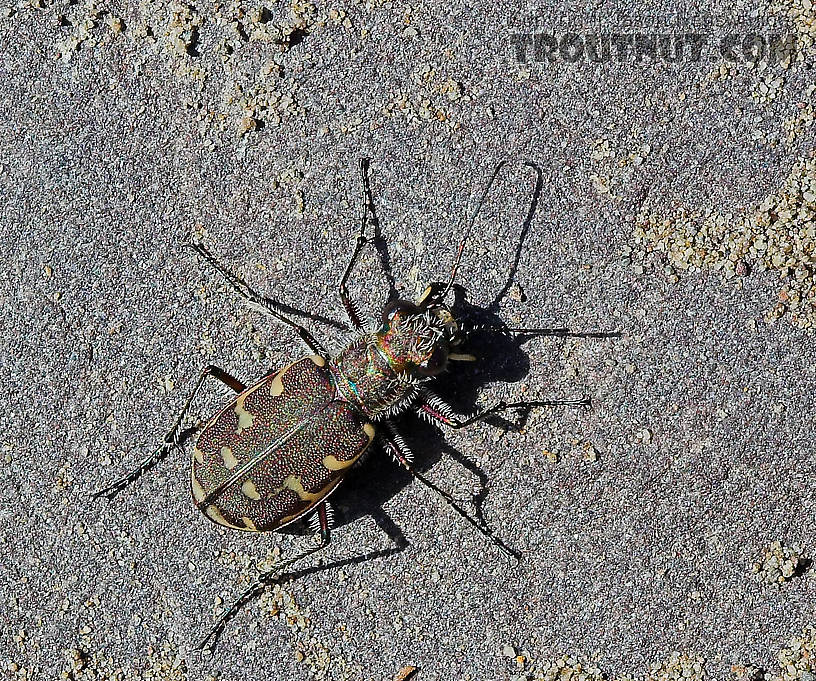
Many beetles of this species were jumping around the rocks like popcorn on a mid-April afternoon. I'm sure they end up in the water for the trout at times.
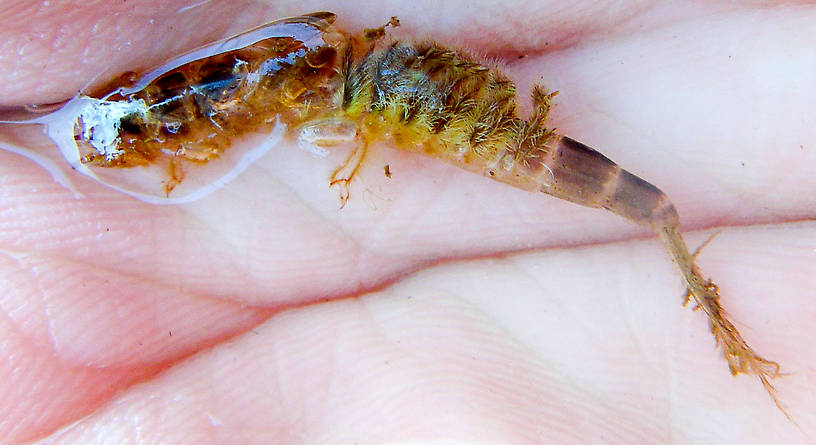
I didn't manage to collect a nymph, but here's the hollow shuck (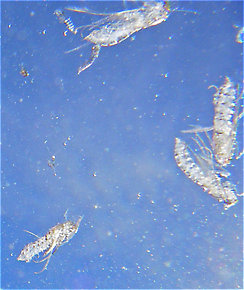 Shuck: The shed exoskeleton left over when an insect molts into its next stage or instar. Most often it describes the last nymphal or pupal skin exited during emergence into a winged adult.) left over from an emerged dun, showing the basic pattern of the nymph.
Shuck: The shed exoskeleton left over when an insect molts into its next stage or instar. Most often it describes the last nymphal or pupal skin exited during emergence into a winged adult.) left over from an emerged dun, showing the basic pattern of the nymph.

Here's an underwater view of the pupal shucks of several already-emerged Brachycentrus numerosus caddisflies.
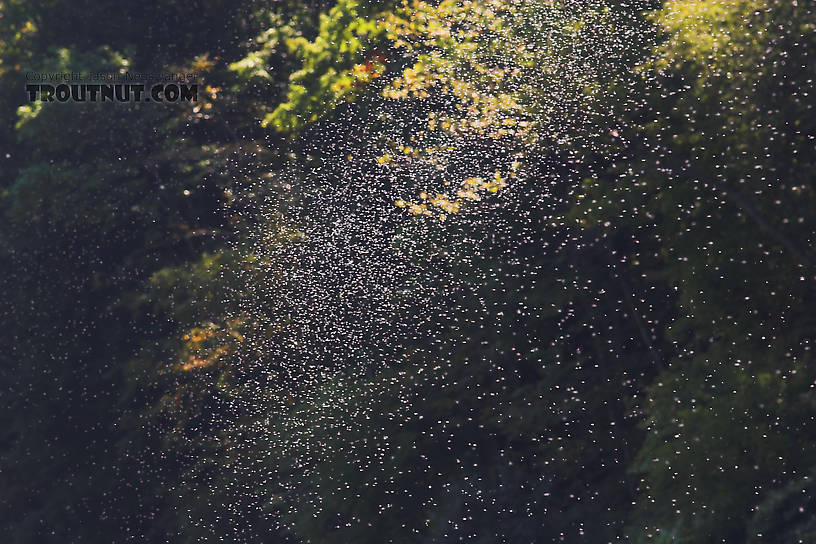
A thick mating swarm of Tricorythodes mayfly spinners hovers the West Branch of the Delaware near Hale Eddy one early fall morning. View the picture full-size and you'll be able to make out the wings and tails on most of those little white dots.
This was one of many such clouds visible all up and down the river. The mayflies were impressive, but the trout did not hold up their end of the bargain -- there was not a rise in sight.
This was one of many such clouds visible all up and down the river. The mayflies were impressive, but the trout did not hold up their end of the bargain -- there was not a rise in sight.
Closeup insects from the West Branch of the Delaware River
Hydropsyche aenigma (Spotted Sedge) Caddisfly Adult View 18 PicturesThese big caddisflies were tempting trout as they wriggled out of their shucks (
View 18 PicturesThese big caddisflies were tempting trout as they wriggled out of their shucks ( Shuck: The shed exoskeleton left over when an insect molts into its next stage or instar. Most often it describes the last nymphal or pupal skin exited during emergence into a winged adult.), while others skated across the water at a medium pace, probably egg-laying.
Shuck: The shed exoskeleton left over when an insect molts into its next stage or instar. Most often it describes the last nymphal or pupal skin exited during emergence into a winged adult.), while others skated across the water at a medium pace, probably egg-laying.
 View 18 PicturesThese big caddisflies were tempting trout as they wriggled out of their shucks (
View 18 PicturesThese big caddisflies were tempting trout as they wriggled out of their shucks (
Here's an underwater view of the pupal shucks of several already-emerged Brachycentrus numerosus caddisflies.
Collected May 15, 2007 from the West Branch of the Delaware River in New York
Added to Troutnut.com by Troutnut on May 18, 2007
Added to Troutnut.com by Troutnut on May 18, 2007
Female Ephemera guttulata (Green Drake) Mayfly Dun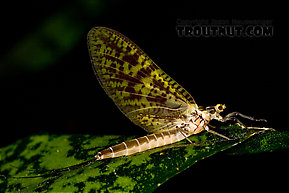 View 16 PicturesIt's about time I got a green drake on this site!
View 16 PicturesIt's about time I got a green drake on this site!
 View 16 PicturesIt's about time I got a green drake on this site!
View 16 PicturesIt's about time I got a green drake on this site!Collected June 1, 2007 from the West Branch of the Delaware River in New York
Added to Troutnut.com by Troutnut on June 4, 2007
Added to Troutnut.com by Troutnut on June 4, 2007
Brachycentrus appalachia (Apple Caddis) Caddisfly Adult View 13 PicturesI captured this specimen in the same color as this photograph, during its egg-laying flight. The emergers are much lighter.
View 13 PicturesI captured this specimen in the same color as this photograph, during its egg-laying flight. The emergers are much lighter.
 View 13 PicturesI captured this specimen in the same color as this photograph, during its egg-laying flight. The emergers are much lighter.
View 13 PicturesI captured this specimen in the same color as this photograph, during its egg-laying flight. The emergers are much lighter.Collected May 13, 2007 from the West Branch of the Delaware River in New York
Added to Troutnut.com by Troutnut on May 18, 2007
Added to Troutnut.com by Troutnut on May 18, 2007
Female Drunella tuberculata Mayfly Dun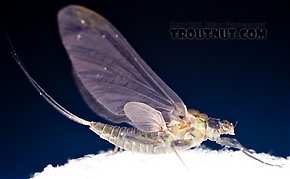 View 14 PicturesI don't know for sure that this is Drunella tuberculata, but that's my best guess for now.
View 14 PicturesI don't know for sure that this is Drunella tuberculata, but that's my best guess for now.
It certainly has a different look and much more robust body shape from Drunella lata duns I photographed a couple weeks earlier, so I doubt it's that species. Using distribution records to eliminate other choices narrows this down to Drunella tuberculata or Drunella walkeri.
Markings described for the abdominal sternites (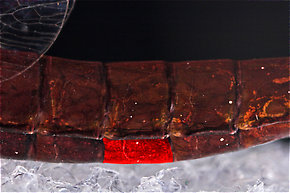 Sternite: The bottom (ventral) part of a single segment on an insect's abdomen.) of the male spinner of Drunella tuberculata are suspiciously similar to those on this female dun. Also, this dun is 9.5mm long (my ruler pic isn't very good, but I'm basing this on measuring the real thing). The size range given in the old Allen & Edmunds keys for walkeri females is 7-8mm, while tuberculata is 9-11mm. For these reasons I'm sticking it in tuberculata for now.
Sternite: The bottom (ventral) part of a single segment on an insect's abdomen.) of the male spinner of Drunella tuberculata are suspiciously similar to those on this female dun. Also, this dun is 9.5mm long (my ruler pic isn't very good, but I'm basing this on measuring the real thing). The size range given in the old Allen & Edmunds keys for walkeri females is 7-8mm, while tuberculata is 9-11mm. For these reasons I'm sticking it in tuberculata for now.
This is the only Drunella mayfly I saw all day. I scooped it off the water as it emerged at around 7pm from a big Catskill tailwater.
 View 14 PicturesI don't know for sure that this is Drunella tuberculata, but that's my best guess for now.
View 14 PicturesI don't know for sure that this is Drunella tuberculata, but that's my best guess for now. It certainly has a different look and much more robust body shape from Drunella lata duns I photographed a couple weeks earlier, so I doubt it's that species. Using distribution records to eliminate other choices narrows this down to Drunella tuberculata or Drunella walkeri.
Markings described for the abdominal sternites (

One sternite of this Isonychia bicolor mayfly spinner is highlighted in red.
This is the only Drunella mayfly I saw all day. I scooped it off the water as it emerged at around 7pm from a big Catskill tailwater.
Collected June 1, 2007 from the West Branch of the Delaware River in New York
Added to Troutnut.com by Troutnut on June 8, 2007
Added to Troutnut.com by Troutnut on June 8, 2007
Brachycentrus appalachia (Apple Caddis) Caddisfly Adult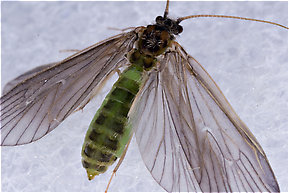 View 9 PicturesThe wings of this specimen were pale tan, almost white, when I collected it, and the body was of the lighter "apple green" from which this species gets its common name. Everything turned much darker by the time I got it home and under the camera.
View 9 PicturesThe wings of this specimen were pale tan, almost white, when I collected it, and the body was of the lighter "apple green" from which this species gets its common name. Everything turned much darker by the time I got it home and under the camera.
The wings look even darker in some of these pictures because the background is black and the wings are unusually translucent. You can see that in one of the pictures where the body easily through the wings. They're really a light, translucent gray, which is still far from the pale tan of the same fly when it was freshly emerged.
 View 9 PicturesThe wings of this specimen were pale tan, almost white, when I collected it, and the body was of the lighter "apple green" from which this species gets its common name. Everything turned much darker by the time I got it home and under the camera.
View 9 PicturesThe wings of this specimen were pale tan, almost white, when I collected it, and the body was of the lighter "apple green" from which this species gets its common name. Everything turned much darker by the time I got it home and under the camera.The wings look even darker in some of these pictures because the background is black and the wings are unusually translucent. You can see that in one of the pictures where the body easily through the wings. They're really a light, translucent gray, which is still far from the pale tan of the same fly when it was freshly emerged.
Collected May 15, 2007 from the West Branch of the Delaware River in New York
Added to Troutnut.com by Troutnut on May 18, 2007
Added to Troutnut.com by Troutnut on May 18, 2007
Recent Discussions of the West Branch of the Delaware River
Trico picture 1 Reply »
This is an e-mail I recieved from someone who I, and other people I know, respect as a person and Fly Fisherman. It was sent to numerous people, so members of this forum might already have recieved it. Does anyone have any more information on what exactly is giong on? I checked the flows on the USGS Website, and they have been quite low the past few days. Does anyone have the address of where to send a vote, or a website address of where to vote? Thanks.Reply
I have seen many instances on the middle West Branch (From Upper Game Lands to Hale Eddy Bridge) where there will be zillions of Trico spinner in the air, and later on the water, and not a single rising fish. Yet from Balls Eddy down to where West Branch enters the main stem you will often find fish rising steadily to the spinners in pods remeniscent of the Missouri river pods of the 1990's. I've never seen Tricos above the Hale eddy bridge.
ReplyUpper Delaware...... 6 Replies »Dear Sirs/Madams:
I am an avid user of the Upper Delaware River. I have walked its banks, waded its pools, canoed its riffles, watched eagles and ospreys fish along side me, talked to families and youth groups as they enjoyed the same precious ecosystem. I purchased one of the first New York State "lifetime super sportsman" licenses and can assure you that I have a sincere interest in all of the natural wonders that make upstate new York a fantastic place to live. As a father, I continue to hope that my two sons will be able to someday experience the beauty of the Upper Delaware River. As an educator, I take students to the river to learn about what a unique treasure it is. I know of no other watershed where striped bass, American shad and sea lampreys can be seen in abundance, having traveled over 200 miles from the ocean without encountering a dam or other major barrier.
I have been extremely concerned over the water resrictions imposed in the past two years that have routinely reduced West Branch flows to levels not before seen. However, the current FFMP cuts previous flows of 280 cfs - 340 cfs at the Hale Eddy monitoring station to flows of less than 150 cfs. The mighty Delaware looks like a very small creek at these flows. Wild trout are compressed into a very small thermal refuge where their survival is compromised, huge areas of river bed are dry and exposed, killing the aquatic organisms that form the base of the food web in the ecosystem. People cannot fish over much of the river's length, taking a boat "ride" or canoe "ride" means exiting the water craft and dragging it over extensive areas only a few inches deep.
I urge you to look at the Upper Delaware River at its current flows before the September 24 vote on FFMP. Please allow this unique and precious river gem to be spared. I am grateful for your time and consideration of my request.
This is an e-mail I recieved from someone who I, and other people I know, respect as a person and Fly Fisherman. It was sent to numerous people, so members of this forum might already have recieved it. Does anyone have any more information on what exactly is giong on? I checked the flows on the USGS Website, and they have been quite low the past few days. Does anyone have the address of where to send a vote, or a website address of where to vote? Thanks.
Start a Discussion of the West Branch of the Delaware River:
Top 10 Fly Hatches
Top Gift Shop Designs
Eat mayflies.
Top Insect Specimens
Miscellaneous Sites
Troutnut.com is copyright © 2004-2024 Jason
Neuswanger (email Jason). See my FAQ for information about use of my images.
 privacy policy
privacy policy
